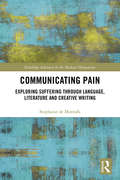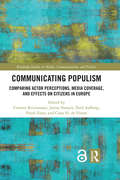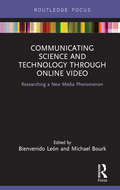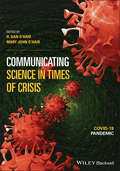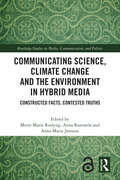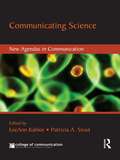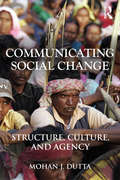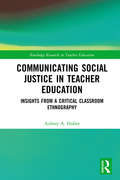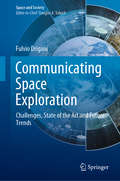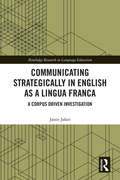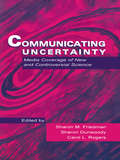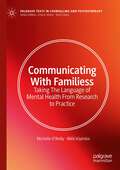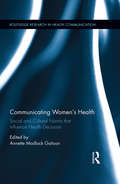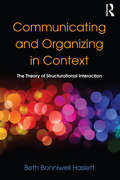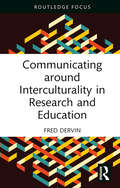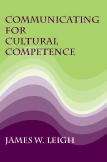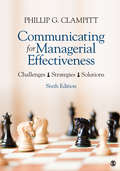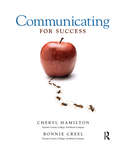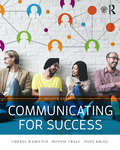- Table View
- List View
Communicating Pain: Exploring Suffering through Language, Literature and Creative Writing (Routledge Advances in the Medical Humanities)
by Stephanie Potocka de MontalkCombining critical research with memoir, essay, poetry and creative biography, this insightful volume sensitively explores the lived experience of chronic pain. Confronting the language of pain and the paradox of writing about personal pain, Communicating Pain is a personal response to the avoidance, dismissal and isolation experienced by the author after developing intractable pelvic pain in 2003. The volume focuses on pain's infamous resistance to verbal expression, the sense of exile experienced by sufferers and the under-recognised distinction between acute and chronic pain. In doing so, it creates a platform upon which scholarly, imaginative and emotional quotients round out pain as the sum of physical actualities, mental challenges and psychosocial interactions. Additionally, this work creates a dialogue between medicine and literature. Considering the works of writers such as Harriet Martineau, Alphonse Daudet and Aleksander Wat, it enables a multi-genre narrative heightened by poetry, fictional storytelling and life-writing. Coupled with academic rigour, this insightful monograph constitutes a persuasive and unique exploration of pain and the communication of suffering. It will appeal to students and researchers interested in fields such as Medical Humanities, Autobiography Studies and Sociology of Health and Illness.
Communicating Popular Science
by Sarah PerraultTechnoscientific developments often have far-reaching consequences, both negative and positive, for the public. Yet, because science has the authority to decide which judgments about scientific issues are sound, public concerns are often dismissed because they are not part of the technoscientific paradigm they question. This book addresses the role of science popularization in that paradox; it explains how science writing works and argues that it can do better at promoting public discussions about science-related issues. To support these arguments, it situates science popularization in its historical and cultural context; provides a conceptual framework for analyzing popular science texts; and examines the rhetorical effects of common strategies used in popular science writing. Twenty-six years after Dorothy Nelkin's groundbreaking book, Selling Science: How the Press Covers Science and Technology, popular science writing is still not meeting its potential as a public interest genre; Communicating Popular Science explores how it can move closer to doing so.
Communicating Populism: Comparing Actor Perceptions, Media Coverage, and Effects on Citizens in Europe (Routledge Studies in Media, Communication, and Politics)
by Claes H. de Vreese James Stanyer Carsten Reinemann Frank Esser Toril AalbergThe studies in this volume conceptualize populism as a type of political communication and investigate it comparatively, focusing on (a) politicians’ and journalists’ perceptions, (b) media coverage, and (c) effects on citizens. This book presents findings from several large-scale internationally comparative empirical studies, funded by the European Cooperation in the field of Scientific and Technical Research (COST), focusing on communication and the media within the context of populism and populist political communication in Europe. The studies are based on comparative interview studies with journalists and politicians, a large-scale comparative content analysis, and a comparative cross-country experiment using nationally representative online-surveys over 15 countries. The book also includes advice for stakeholders like politicians, the media, and citizens about how to deal with the challenge of populist political communication. This enlightening volume is ‘populist’ in the best sense and will be an essential text for any scholar in political science, communication science, media studies, sociology and philosophy with an interest in populism and political communication. It does not assume specialist knowledge and will remain accessible and engaging to students, practitioners and policymakers.
Communicating Science and Technology Through Online Video: Researching a New Media Phenomenon (Routledge Focus on Communication Studies)
by Bienvenido León Michael BourkOnline video’s unique capacity to reach large audiences makes it a powerful tool to communicate science and technology to the general public. The outcome of the international research project "Videonline," this book provides a unique insight into the key elements of online science videos, such as narrative trends, production characteristics, and issues of scientific rigor. If offers various methodological approaches: a literature review, content analysis, and interviews and surveys of expert practitioners to provide information on how to maintain standards of rigour and technical quality in video production.
Communicating Science in Times of Crisis: COVID-19 Pandemic (Communicating Science In Times Of Crisis Ser.)
by Mary John O’Hair H. Dan O’HairtyLearn more about how people communicate during crises with this insightful collection of resources In Communicating Science in Times of Crisis: COVID-19 Pandemic, distinguished academics and editors H. Dan O’Hair and Mary John O’Hair have delivered an insightful collection of resources designed to shed light on the implications of attempting to communicate science to the public in times of crisis. Using the recent and ongoing coronavirus outbreak as a case study, the authors explain how to balance scientific findings with social and cultural issues, the ability of media to facilitate science and mitigate the impact of adverse events, and the ethical repercussions of communication during unpredictable, ongoing events. The first volume in a set of two, Communicating Science in Times of Crisis: COVID-19 Pandemic isolates a particular issue or concern in each chapter and exposes the difficult choices and processes facing communicators in times of crisis or upheaval. The book connects scientific issues with public policy and creates a coherent fabric across several communication studies and disciplines. The subjects addressed include: A detailed background discussion of historical medical crises and how they were handled by the scientific and political communities of the time Cognitive and emotional responses to communications during a crisis Social media communication during a crisis, and the use of social media by authority figures during crises Communications about health care-related subjects Data strategies undertaken by people in authority during the coronavirus crisis Perfect for communication scholars and researchers who focus on media and communication, Communicating Science in Times of Crisis: COVID-19 Pandemic also has a place on the bookshelves of those who specialize in particular aspects of the contexts raised in each of the chapters: social media communication, public policy, and health care.
Communicating Science, Climate Change and the Environment in Hybrid Media: Constructed Facts, Contested Truths (Routledge Studies in Media, Communication, and Politics)
by Anna Rantasila Mette Marie Roslyng Anna Maria JönssonThis volume examines how a new hybrid mediascape represents and contributes to the construction of facts and knowledge in relation to science, environment, and climate controversies, providing a new, critical perspective to the bourgeoning field of science and environment communication.Arguing that science must be understood from an inclusive perspective, respecting public values and concerns alongside scientific arguments, the authors demonstrate how this will allow us to properly understand the role of science, truth, and factuality alongside the ethical, cultural, and political concerns about science raised in different publics. The chapters focus on the more controversial aspects of science and environmental communication: misinformation, public understandings of science and the environmental crises, vaccination, and the role of the hybrid mediascape in science, environment, and climate conflicts.Offering a much-needed interdisciplinary approach to understand the role of science of media in science and environment conflicts, this book will appeal to students and academics in the areas of media and communication, journalism, cultural studies, science, environment and risk communication, and digital media studies, as well as sociology and political science.The Open Access version of this book, available at www.taylorfrancis.com, has been made available under a Creative Commons Attribution-Non Commercial-No Derivatives (CC-BY-NC-ND) 4.0 license. An electronic version of this book is freely available, thanks to the support of libraries working with Knowledge Unlatched (KU). KU is a collaborative initiative designed to make high quality books Open Access for the public good. The Open Access ISBN for this book is 9781003479550. More information about the initiative and links to the Open Access version can be found at www.knowledgeunlatched.org.
Communicating Science: New Agendas in Communication (New Agendas in Communication Series)
by LeeAnn Kahlor Patricia StoutThis volume explores the evolution of science communication, addressing key issues and offering substance for future study. Harnessing the energies of junior scholars on the forefront of science communication, this work pushes the boundaries of research forward, allowing scholars to sample the multiple paradigms and agendas that will play a role in shaping the future of science communication. Editors LeeAnn Kahlor and Patricia Stout challenge their readers to channel the energy within these chapters to build or continue to build their own research agendas as all scholars work together – across disciplines – to address questions of public understanding of science and communicating science. These chapters are intended to inspire still more research questions, to help aspiring science communication scholars locate their own creative and original research programs, and to help veteran science communication scholars expand their existing programs such that they can more actively build interdisciplinary bridges. Crossing methodological boundaries, work from quantitative and qualitative scholars, social scientists and rhetoricians is represented here. This volume is developed for practitioners and scholars alike – for anyone who is concerned about or interested in the future of science and how communication is shaping and will continue to shape that future. In its progressive pursuit of interdisciplinary research streams – of thinking outside methodological and theoretical boxes – this book inspires science communication scholars at all levels to set a new standard for collaboration not just for science communication, but for communication research in general.
Communicating Social Change: Structure, Culture, and Agency (Routledge Communication Series)
by Mohan J. DuttaCommunicating Social Change: Structure, Culture, and Agency explores the use of communication to transform global, national, and local structures of power that create and sustain oppressive conditions. Author Mohan J. Dutta describes the social challenges that exist in current globalization politics, and examines the communicative processes, strategies, and tactics through which social change interventions are constituted in response to the challenges. Using empirical evidence and case studies, he documents the ways through which those in power create conditions at the margins, and he provides a theoretical base for discussing the ways in which these positions of power are resisted through communication processes, strategies, and tactics. The interplay of power and control with resistance is woven through each of the chapters in the book. This exceptional volume highlights the points of intersection between the theory and praxis of social change communication, creating theoretical entry points for the praxis of social change. It is intended for communication scholars and students studying activism, social movements, and communication for social change, and it will also resonate in such disciplines such as development, sociology, and social work, with those who are studying social transformations.
Communicating Social Justice in Teacher Education: Insights from a Critical Classroom Ethnography (Routledge Research in Teacher Education)
by Aubrey A. HuberEvolving out of ethnographic fieldwork, this text examines how ideas of social justice are articulated and communicated by pre-service teachers and graduate teaching assistants in the US. By positing the concept of "help" as a central tenet of social justice within teacher education, this volume offers a unique performative analysis of how the concept is communicatively constituted in teacher education and training. Using a social justice framework, the book examines the ways in which new teachers contend with their identities as educators, and demonstrates how these communicative performances influence pre-service and new teachers’ perceptions of their role, as well as their responsibility to engage with social justice and critical approaches in the classroom. This text will benefit researchers, academics, and educators in higher education with an interest in teacher education, critical communication studies, and the sociology of education more broadly. Those specifically interested in teacher training, mentoring, and social justice in the classroom will also benefit from this book.
Communicating Social Support
by Daena J. GoldsmithWe often turn to our friends, family, spouses, and partners for help in coping with daily stress or major crises. Daena Goldsmith provides a communication-based approach for understanding why some conversations about problems are more helpful than others. In contrast to other research on the social support processes, Goldsmith focuses on interpersonal communication--what people say and how they say it, as well as their reactions to the conversations. Her studies cover adults of all ages and various kinds of stresses, ranging from everyday hassles to serious illnesses and other major crises.
Communicating Space Exploration: Challenges, State of the Art and Future Trends (Space and Society)
by Fulvio DriganiThis book offers an enlightening analysis of the ways in which the communication of space explorations has evolved in response to political and social developments and the availability of new media and communication tools. Important challenges to effective communication are discussed, including the diversity of audiences, the risks associated with space missions, and continuing skepticism about the benefits of space research despite the many associated day-to-day applications. In addition, future trends in communication are examined with reference to likely trends in space exploration over the coming century. Besides space communication for the public, the need for targeted messaging to each group of stakeholders – decision makers, media, opinion leaders, the scientific community, and industry – is analyzed in detail. A series of case studies of particular space missions, both successful and unsuccessful, is presented to illustrate key issues. The book has significant implications for the communication of science in general and will be of interest to a wide audience, including space scientists, science communication professionals, people fascinated by exploration and discovery, stakeholders, and educators.
Communicating Strategically in English as a Lingua Franca: A Corpus Driven Investigation (Routledge Research in Language Education)
by Janin JafariThere have been noticeable demographic changes recently in the use of English around the world. English as a medium of communication is now the contact language of native speakers from many diverse speech communities who interact with each other in multilingual contexts. The use of English as a lingua franca (ELF) and its implications has become a hot topic in applied linguistics and English studies. Communicating Strategically in English as a Lingua Franca reflects the growing interest in achieving communicative effectiveness in ELF situations and provides a comprehensive account of recent empirical findings in the field of ELF. It analyzes and interprets the author's own large corpus of naturally occurring spoken interactions and focuses on identifying innovative employments in the communicative strategies and pragmatics of speakers involved in ELF interactions. In doing so, this book makes a considerable contribution to the growing field of empirical studies in ELF. It explores the usage of pragmatic strategies and highlights their significant role in communicative effectiveness in ELF interactions. In showing the processes of classifying communication strategies involved in the identification of newly observed communication strategies, this book will be of great interest to English linguists, applied linguists, graduate and undergraduate students of English, English Language Teaching material developers and teachers of English.
Communicating Terror: The Rhetorical Dimensions of Terrorism
by Joseph S. TumanThe only book to examine terrorism as a rhetorical act "This is an excellent text in furthering our understanding of the web of language and how it creates our mediated realities – which reflect our culture, politics, religion, economics, etc. Students really like the case studies and how it complements the theory and practice of rhetoric. I think this book has applications for almost any course in communication." —J. Gregory Payne, Emerson College Concise, succinct, and provocative, Communicating Terror, Second Edition explores multiple rhetorical dimensions of terrorism, connects terrorism to communication theories, and helps readers understand how this violence creates a public discourse for multiple target audiences. Author Joseph S. Tuman uses fascinating case studies and examples as he explores both dissent terrorism and state terror and looks at terrorism from a communicative perspective. Presenting terrorism as a process of communication between terrorists and multiple audiences, this book examines a range of rhetorical components, including definitions and labels, symbolism in terrorism, the relationship between terror and the media, and public oratory about terrorism—by both victims of terrorism and terrorists themselves.New to the Second EditionIncludes three new chapters on public address and speeches concerning terrorism, symbols and targets of terror, and terrorism, rhetorical theory, and mass media.Offers new examples, case studies, speeches, and topic coverage, including expanded coverage of the Internet and the "War on Terror;" new material on Iran, Cambodia, Rwanda, Hamas and Hezbollah, and dirty bombsProvides expanded treatment of rhetoric and theory with a focus on ideological criticism, neo-classical criticism, dramatism, and media-centered terrorismExamines diverse acts of terrorism—not just 9/11 or the recent events in the Middle East—to show the history and various usages of these acts as a medium for communicationIncludes real case studies of terrorists and terror acts that make applying rhetorical theory practical and accessibleIntended AudienceCommunicating Terror, Second Edition is ideal for use in a wide range of courses, including Media & Politics, Terrorism, Media & Society, Rhetorical Theory/Analysis/Criticism, Defense and National Security, and Political Communication.
Communicating Uncertainty: Media Coverage of New and Controversial Science (Routledge Communication Series)
by Sharon M. Friedman Sharon Dunwoody Carol L. RogersExploring the interactions that swirl around scientific uncertainty and its coverage by the mass media, this volume breaks new ground by looking at these issues from three different perspectives: that of communication scholars who have studied uncertainty in a number of ways; that of science journalists who have covered these issues; and that of scientists who have been actively involved in researching uncertain science and talking to reporters about it. In particular, Communicating Uncertainty examines how well the mass media convey to the public the complexities, ambiguities, and controversies that are part of scientific uncertainty. In addition to its new approach to scientific uncertainty and mass media interactions, this book distinguishes itself in the quality of work it assembles by some of the best known science communication scholars in the world. This volume continues the exploration of interactions between scientists and journalists that the three coeditors first documented in their highly successful volume, Scientists and Journalists: Reporting Science as News, which was used for many years as a text in science journalism courses around the world.
Communicating With Families: Taking The Language of Mental Health From Research to Practice (Palgrave Texts in Counselling and Psychotherapy)
by Michelle O'Reilly Nikki KiyimbaThis textbook uniquely highlights the particular complexities of working systemically with couples and families with children. It is designed to be student and practitioner oriented by drawing on real world examples of therapeutic encounters in mental health settings to illustrate how theory can inform practice. Good communication is the cornerstone of good clinical practice and is foundational for building therapeutic alliance. Although therapists and counsellors are often highly skilled in their therapeutic modalities, this book offers additional practical suggestions about how families engage in social actions and positioning themselves and others in their talk. The book also takes wider micro and macro ecological systems within which systemic psychotherapists and counsellors work into account and consider the ways that these larger social influences are experienced within institutional discourses. The book will be a valuable resource across a broad spectrum of professions and researchers, including counsellors, psychotherapists, family therapists, psychiatrists, nurses, play therapists, speech and language therapists, and mental health social workers.
Communicating Women's Health: Social and Cultural Norms that Influence Health Decisions (Routledge Research in Health Communication)
by Annette Madlock GatisonThis volume explores the conditions under which women are empowered, and feel entitled, to make the health decisions that are best for them. At its core, it illuminates how the most basic element of communication, voice, has been summarily suppressed for entire groups of women when it comes to control of their own sexuality, reproductive lives, and health. By giving voice to these women’s experiences, the book shines a light on ways to improve health communication for women. Bringing together personal narratives, key theory and literature, and original qualitative and quantitative studies, the book provides an in-depth comparative picture of how and why women’s health varies for distinct groups of women. Organized into four parts—historical influences on patient and provider perceptions, breast cancer the silence and the shame, make it taboo: mothering, reproduction, and womanhood, and sex, sexuality, relational health, and womanhood—each section is introduced with a brief synthesis and discussion of the key questions addressed across the chapters.
Communicating and Organizing in Context: The Theory of Structurational Interaction (Routledge Communication Series)
by Beth Bonniwell HaslettCommunicating and Organizing in Context integrates Giddens’ structuration theory with Goffman’s interaction order and develops a new theoretical base—the theory of structurational interaction—for the analysis of communicating and organizing. Both theorists emphasize tacit knowledge, social routines, context, social practices, materiality, frames, agency, and view communication as constitutive of social life and of organizing. Thus their integration in structurational interaction provides a coherent, communication-centric approach to analyzing communicating, organizing and their interrelationships. This book will be a valuable resource for students and scholars as an orientation to the field of organizational communication and as an integration of organizing and communicating. It will also be useful for practitioners as a tool for understanding how conceptual frames limit possibilities and constitute the nature of organizing and members' participation in organizations.
Communicating around Interculturality in Research and Education (New Perspectives on Teaching Interculturality)
by Fred DervinThis book does not instruct the reader how to communicate interculturally but supports them in reflecting on how they can (re-)negotiate and (re-)construct knowledge(s), ideologies and relations around the notion of interculturality. Anchored in the author’s original and thought-provoking perspectives on interculturality, this interdisciplinary and global-minded book explores how communicating around the notion cannot do away with ideologisms, issues of language and translation or the problematization of voice and silence in research and education. Written in an original and stimulating way, relying on different writing genres and styles to ‘mimic’ the dynamism and flexibility of the very notion under review, the author urges us to (un-)voice, scrutinize, nurture and galvanize our ways of dealing with interculturality alone and together with others in academia. The very specific focus of the book, communicating around interculturality (instead of ‘doing’ interculturality), represents a fresh and important move for observing, analyzing, speaking of and contributing to today's complex and divided world. The title is aimed at researchers, students and educators interested in examining and enriching their own takes on interculturality, from a more reflexive and interactive perspective.
Communicating at Work: Strategies For Success in Business and the Professions (11th Edition)
by Ronald B. Adler Jeanne Marquardt Elmhorst Kristen LucasThe 11th edition of Communicating at Work enhances the strategic approach, real-world practicality, and reader-friendly voice that have made this text the market leader for three decades. On every page, students learn how to communicate in ways that enhance their own career success and help their organization operate effectively. This edition retains the hallmark features that have been praised by faculty and students--a strong emphasis on ethical communication and cultural diversity, discussions of evolving communication technologies, and self-assessment tools--while incorporating important updates and ground-breaking digital teaching and learning tools to help students better connect to the course material and apply it to real world business situations.
Communicating at the End of Life: Finding Magic in the Mundane (LEA's Series on Personal Relationships)
by Elissa FosterThis enlightening volume provides first-hand perspectives and ethnographic research on communication at the end of life, a topic that has gone largely understudied in communication literature. Author Elissa Foster’s own experiences as a volunteer hospice caregiver form the basis of the book. Communicating at the End of Life recounts the stories of Foster and six other volunteers and their communicative experiences with dying patients, using communication theory and research findings to identify insights on the relationships they form throughout the process. What unfolds is a scholarly examination of a subject that is significant to every individual at some point in the life process. Organized chronologically to follow the course of Foster’s involvement with hospice and the phases of the study, the book opens with Part 1, providing background and contextual information to help readers understand subsequent stories about communication between volunteers and patients. Part 2 of the volume emphasizes the adjustments required by the volunteers as they entered the world of hospice and the worlds of the patients. Part 3 underscores the importance of improvisation and finding balance within the role of volunteer—in particular how to be fully present for patients as well as their family members. The volume concludes with Part 4, which addresses how volunteers coped with the death of their patients and what they learned from the experience of volunteering. Communicating at the End of Life is appropriate for scholars and advanced students studying personal relationships, health communication, gerontology, interpersonal communication, lifespan communication, and communication & aging. Its unique content offers precious and meaningful insights on the communication processes at a critical point in the life process.
Communicating for Cultural Competence
by James W. LeighExplains and demonstrates a model for social workers to communicate with persons of color by casting them in the role of experts on their own lives. Emphasis is placed on the beginning stage of the helping process, the information-gathering stage. What happens next is not addressed directly, although there is a lengthy appendix on culturally relevant treatment and interventions. Early chapters address information for achieving the role of a culturally competent social worker. Subsequent chapters outline steps of the interview model based on the ethnographic interviewing work of James Spradley. Includes chapter exercises and illustrations from interviews drawn from the author's practice and published cases. Appendices offer principles and codes of ethics. Annotation c. by Book News, Inc. , Portland, Or.
Communicating for Managerial Effectiveness: Challenges | Strategies | Solutions
by Phillip G. ClampittAppreciated by thousands of thoughtful students, successful managers, and aspiring senior leaders around the world Communicating for Managerial Effectiveness skillfully integrates theory, research, and real-world case studies into models designed to guide thoughtful responses to complex communication issues. The highly anticipated Sixth Edition builds on the strategic principles and related tactics highlighted in previous editions to show readers how to add value to their organizations by communicating more effectively. Author Phillip G. Clampitt (Blair Endowed Chair of Communication at the University of Wisconsin–Green Bay) addresses common communication problems experienced in organizations, including: Communicating about major changes spanning organizational boundaries Selecting the proper communication technologies Transforming data into knowledge Addressing ethical dilemmas Providing useful performance feedback Structuring and using robust decision-making practices Cultivating the innovative spirit Building a world-class communication system
Communicating for Managerial Effectiveness: Challenges | Strategies | Solutions
by Phillip G. ClampittAppreciated by thousands of thoughtful students, successful managers, and aspiring senior leaders around the world Communicating for Managerial Effectiveness skillfully integrates theory, research, and real-world case studies into models designed to guide thoughtful responses to complex communication issues. The highly anticipated Sixth Edition builds on the strategic principles and related tactics highlighted in previous editions to show readers how to add value to their organizations by communicating more effectively. Author Phillip G. Clampitt (Blair Endowed Chair of Communication at the University of Wisconsin–Green Bay) addresses common communication problems experienced in organizations, including: Communicating about major changes spanning organizational boundaries Selecting the proper communication technologies Transforming data into knowledge Addressing ethical dilemmas Providing useful performance feedback Structuring and using robust decision-making practices Cultivating the innovative spirit Building a world-class communication system
Communicating for Success
by Cheryl Hamilton Bonnie CreelThis text focuses student-learning on the key communication competencies recommended by the National Communication Association. With applied examples and a vibrant and engaging design, this text covers all the expected topics in an introductory course (foundations of communication, interpersonal communication, small group communication, and public speaking - plus a special appendix on interviewing). Scenarios begin each chapter with a problem to which students can relate and then solve as they learn about the concepts discussed in each chapter. A concentrated focus on careers in communication, highlighted in a two-page spread near the end of each chapter, brings home the relevance of communication outside the classroom and helps students learn more about how studying communication can help them throughout their lives. Additional emphasis on topics such as ethics, culture, gender, and technology is found throughout the text.
Communicating for Success (Second Edition)
by Cheryl Hamilton Bonnie Creel Tony KrollCommunicating for Success, 2nd edition, focuses student learning on the key communication competencies recommended by the National Communication Association. With a vibrant and engaging design, this introductory volume is packed with applied examples, features, and exercises; the text and accompanying Web content offer practical scenarios, key terms, discussion questions, sample activities, learning objectives, and more. A concentrated focus on the influence of communication on careers in business, education, and healthcare is highlighted near the end of each chapter and takes lessons beyond the classroom. This new edition features broader discussion of communication’s relation to social media and technology, culture, gender, and ethics.
